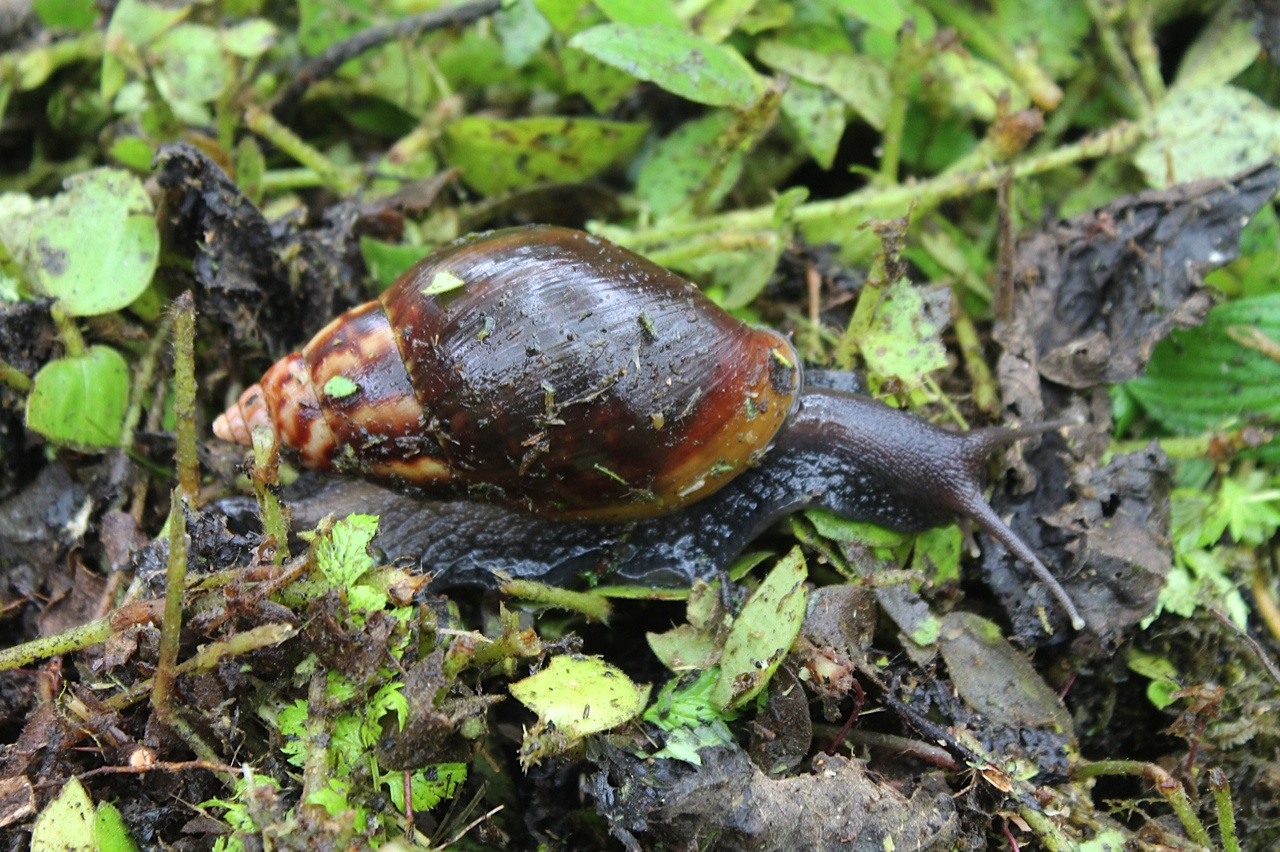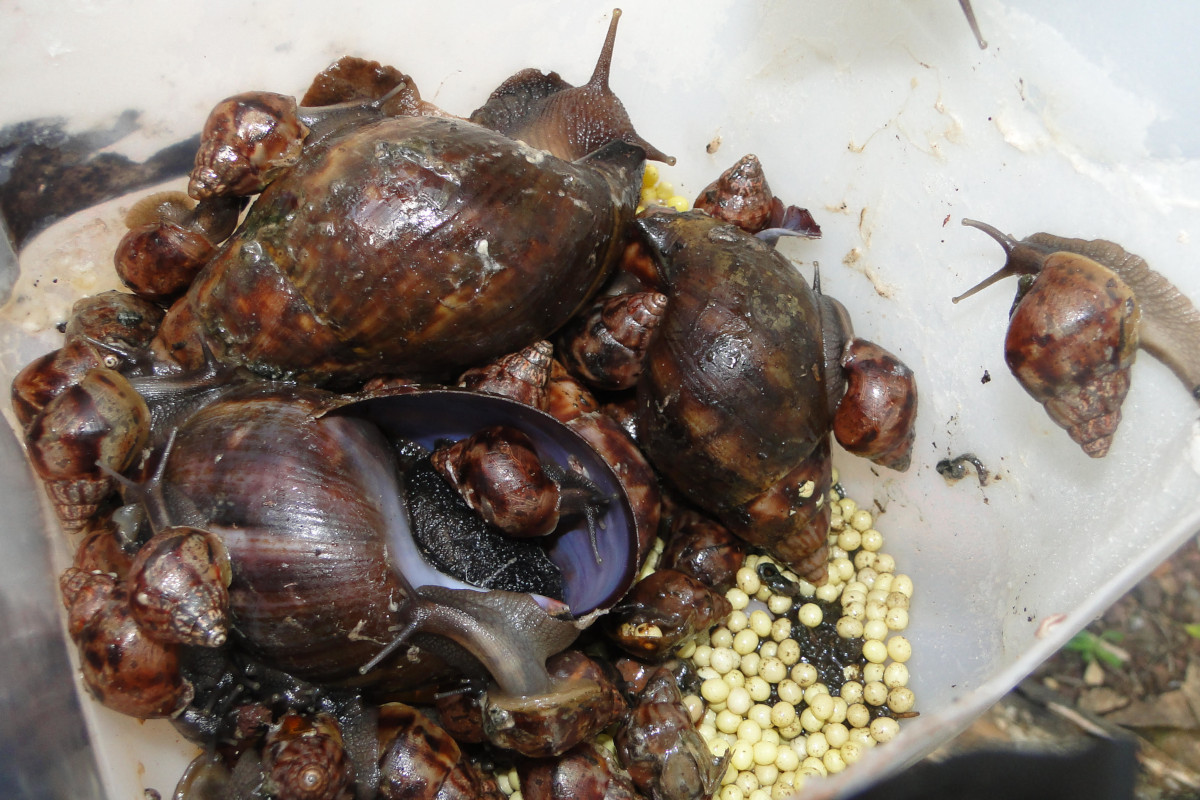Galapagos Species Database
The Galapagos Species Database shares the information about the species from our Natural History Collections.
Lissachatina fulica
Caracol africano, Caracol gigante africano, Giant African land snail



A large snail with a narrow, conical, often coffee-colored shell that can reach up to 20 cm in length. The shell is usually light brown with darker brown vertical stripes. It is a hermaphrodite, but needs to mate with another snail to produce eggs. Eggs are round, yellow to cream in color, 5 mm in length, and are typically laid in groups of 100-400.
Domain
Eukaryota
Kingdom
Animalia
Phylum
Mollusca
Class
Gastropoda
Order
Stylommatophora
Superfamily
Achatinoidea
Family
Achatinidae
Genus
Lissachatina
Species
fulica
Taxon category: Accepted
Syn. Achantina fulica Bowdich, 1822; this formal name change has not yet been published but is followed here because of an email by F. Naggs (The Natural History Museum, London) suggesting that molecular evidence of an unpublished PhD thesis strongly supports his morphological interpretation that Lissachantina should be recognized as a distinct genus based on its anatomical reproductive differences from Achatina s.str.
Origin: Introduced - established
Year of first record: 2010
Mode of introduction: Intentional
Introduction Pathway: Intentional
Subpathway: Animals for breeding
Introduced status: Naturalized
Invasive status: Invasive
Impact in Galapagos: The impact of the snail has not been studied. Snail populations have been maintained at low levels through management efforts by Agrocalidad-SICGAL, Galapagos Biosecurity Agency (ABG), and Galapagos National Park Directorate (GNPD).
Impact elsewhere: This species has devastating effects on agriculture as it eats economically important plants including banana, coffee, citrus, cacao, tomato, tea, and tobacco. It is also a vector for plant and human diseases including eosinophilic meningitis caused by the parasitic rat lungworm. There is some concern that it may compete with native molluscs for food and that it preys on native snails. There is also evidence that snails can suffocate chicks.
Control History in Galapagos: Following its discovery, an intensive campaign was carried out in Santa Cruz to contain the snail. The campaign was coordinated by Agrocalidad –SICGAL with support from GNPD. Snail control is now being coordinated by ABG. Management efforts involve clearing areas of vegetation and the collection and incineration of all eggs and snails that are found. In some areas the vegetation is burnt to eliminate snails. In areas where this is not possible, such as in park areas, the vegetation is cut back. Monitoring and control was initially conducted during the day, but is now carried out at night to catch snails when they are active.
Control methods elsewhere: This species is extremely difficult to contain and eradicate. Control options that have a low impact on nontarget species include the manual removal of eggs and snails and trapping using large pitfall traps (buckets that are placed in holes in the ground –top of bucket is level with the ground) with attractants such as beer or banana. Snails can also be stopped entering small areas by barriers or fences of Annona glabra, metal, wire or copper strips. Iron phosphate is becoming more popular for killing snails and has fewer negative consequences to native fauna. Some of the control measures that have been used against the giant African snail have caused serious problems such as the introduction of a carnivorous snail (Euglandina rosea) as a biological control agent and the use of chemical pesticides such as metaldehyde. Both of these management techniques have had a large impact on native invertebrates. Metaldehyde also affects vertebrates.
Known Pest elsewhere: Northwest Africa, Japan, Pacific Islands, Australia, Americas, Southeast Asia.
Prevention options: Avoid movement of plants and soil between places. Check vehicles and machinery for eggs and snails.
Preference for an altitude zone in Galapagos: Transition zone - humid zone
Habitat preferences: Thrives in warm tropical climates with mild temperatures all year round and high humidity. The species is found in agricultural areas, coastal areas and wetlands, disturbed areas, natural and planted forests, riparian zones, scrublands and shrublands, and the urban zones.
Feeding preferences: Mature, adult snails generally feed on decaying organic matter, including garbage, fallen fruit and animal manure. Younger snails feed on living plants, especially flowers and vegetables, and are known to feed on over 500 plant species. Although typically herbivorous this species of snail has also been reported preying on other snails.
Trophic role: Herbivorous
Persistence mechanisms: Snails “hibernate” under rocks or in loose soil during less favorable conditions (dry or cool weather).
Reproduction mode: Exclusively sexual
Reproductive biology: Lissachatina fulica is an obligate-outcrossing hermaphrodite, individuals produce both male and female gametes, but cannot self-fertilize. Eggs only hatch at temperatures above 15°C and can hatch within a few hours up to 17 days. The snails are sexually mature at 6 months of age, and may live up to 5-9 years during which they may lay a total of 1,000 eggs.
Distribution origin: Eastern Africa
Dispersal propagule: Snails may travel up to 125 m per month (especially in wet weather). Moved by humans on plants, soil, garden rubbish, building materials, vehicles and equipment.
Economic Use: Lissachatina fulica has an economic importance as a medicinal and protein source. It was introduced into Galapagos because it was believed to have regenerative properties.
Disease vector: This snail is a vector of the rat lungworm, Angiostrongylus cantonensis, which causes meningoencephalitis in humans. It has also been reported vectoring plant pathogens such as Phytophthora spp.
Distribution: Discovered on Santa Cruz in March 2010, present in the towns of Bellavista and Puerto Ayora, agricultural areas, and the National Park. Reported on San Cristobal in April 2011, but its presence there has not been reported since.
- Bequaert, J.C. (1950) Studies in the Achatinidae, a Group of African land snails. Bulletin of the Museum of Comparative Zoology 105 (1): 1-216
- Bequaert, J.C. (1950) Studies in the Achatinidae, a Group of African land snails. Bulletin of the Museum of Comparative Zoology 105 (1): 1-216
- Budha, P.B. Naggs F. (2008) The Giant African Land Snail Lissachatina fulica (Bowdich) in Nepal The Malacologist 50: 19-21
- Correoso, M. (2006) Estrategia preliminar para evaluar y erradicar Achatina fulica (Gastropoda: Achatinaceae) en Ecuador. Boletín Técnico 6, Serie Zoológica 2: 45-52.
- Cowie, R.H. (1998) Patterns of introduction of non-indigenous non-marine snails and slugs in the Hawaiian Islands. Biodiversity and Conservation 7: 349-368.
- Miquel, S.E. Herrera, W.H. (2014) Catalogue of terrestrial gastropods from Galapagos (exept Bulimulidae and Succineidae) with description of a new species of Ambrosiella odhner (Achatinellidae) Molluskenfunde 143 (2) 107-133
- Raut, S. K. Barker, G. M. (2002) Achatina fulica Bowdich and Other Achatinidae as Pests in Tropical Agriculture. In: Barker, G. M. (ed.) Molluscs as Crop Pests. Hamilton, New Zealand. CABI Publishing.
- Thiengo, S. C. Faraco, F. A., Salgado, N. C., Cowie, R. H., & Fernandez, M. A. (2007) Rapid spread of an invasive snail in South America: the giant African snail, Achatina fulica, in Brasil. Biological Invasions, 9(6), 693-702.
You are welcome to download and use the information found in this page, acknowledging its source.
This page should be cited as follows:
"Galapagos Species Database, Lissachatina fulica", dataZone. Charles Darwin Foundation, https://datazone.darwinfoundation.org/en/checklist?species=18132. Accessed 25 November 2025.

